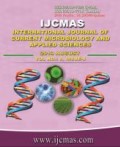


 National Academy of Agricultural Sciences (NAAS)
National Academy of Agricultural Sciences (NAAS)

|
PRINT ISSN : 2319-7692
Online ISSN : 2319-7706 Issues : 12 per year Publisher : Excellent Publishers Email : editorijcmas@gmail.com / submit@ijcmas.com Editor-in-chief: Dr.M.Prakash Index Copernicus ICV 2018: 95.39 NAAS RATING 2020: 5.38 |
The field experiment was carried out at Agricultural Research station, Gangavathi (Karnataka), during 2018-19 and 2019-20 to study the influence of M0–furrow, M1–surface drip and M2–subsurface drip irrigation techniques and irrigation salinity levels of S0–0.65 dS m-1 (normal water), S1–2 dS m-1, S2–3 dS m-1, S3–4 dS m-1 and S4–5 dS m-1 on tomato (Solanum lycopersicum) growth parameters under Vertisols of Tungabhadra Project Command. During two years, the growth attributes such as plants per treatments, plant height during 30, 60, 90 and 120 days after transplanting (DAT), number of branches per plant during 30, 60, 90 and 120 DAT, number of fruits were significantly influenced by the different irrigation techniques and different irrigation saline water levels. The maximum number of plants per treatments, plant height and number of branches per plant during 30, 60, 90 and 120 DAT were recorded higher under subsurface and surface drip as compared to furrow irrigation except plant height during 30 DAT. Similarly, under different irrigation saline water levels, maximum number of plants, plant height and branches were recorded under 0.65 dS m-1 and 2 dS m-1 treatment and least was recorded in 5 dS m-1 treatment. From the study it was concluded that the growth of tomato was good under subsurface drip and surface drip as compared to furrow irrigation under main treatments and under sub treatments, 0.65 and 2 dS m-1 treatments performed better as compared to higher salinity levels. Whenever there is shortage of fresh water, saline water upto 2 dS m-1 can be used to grow tomato without much effect on the crop growth.
 |
 |
 |
 |
 |